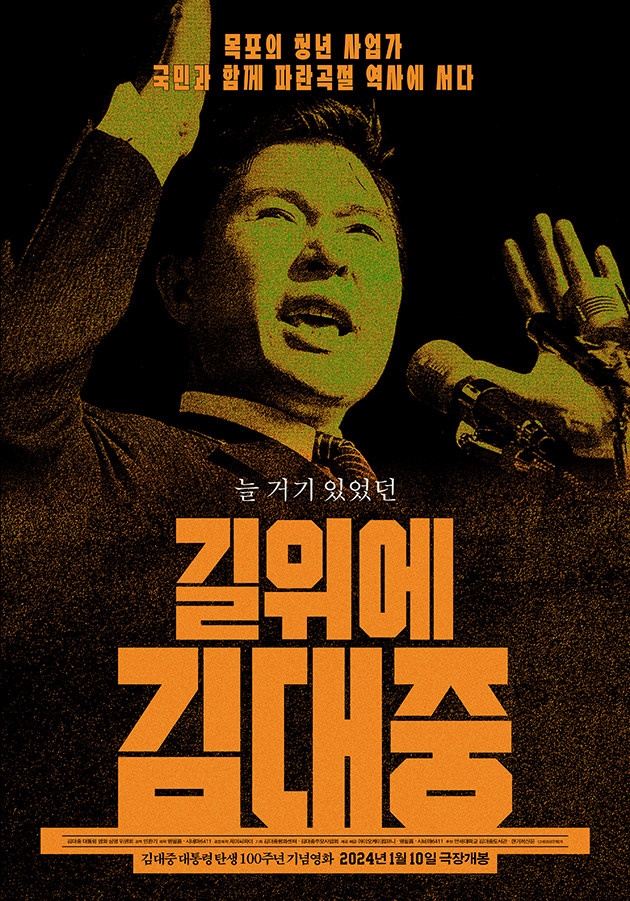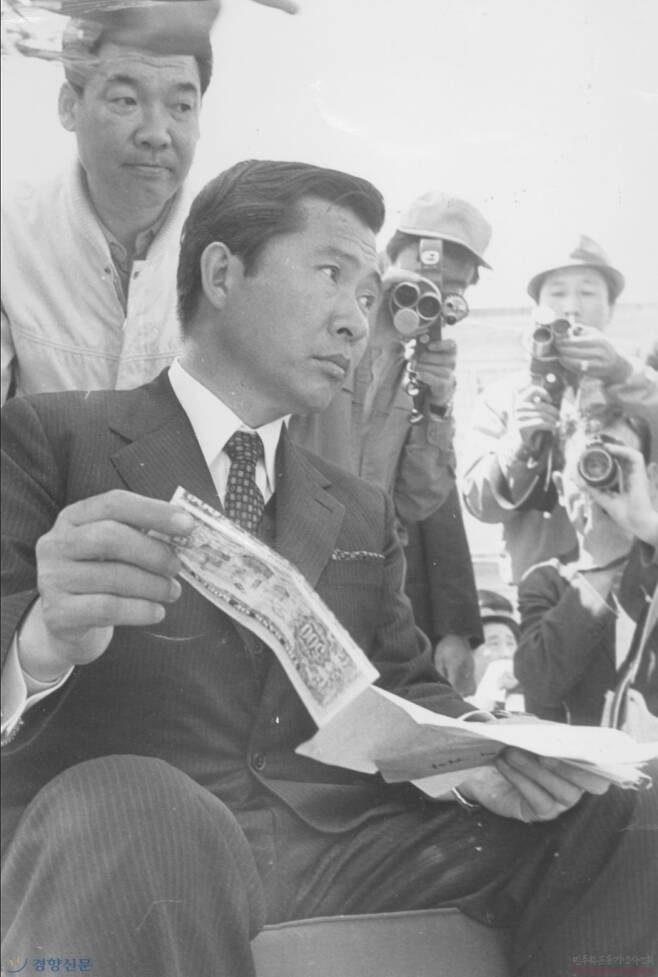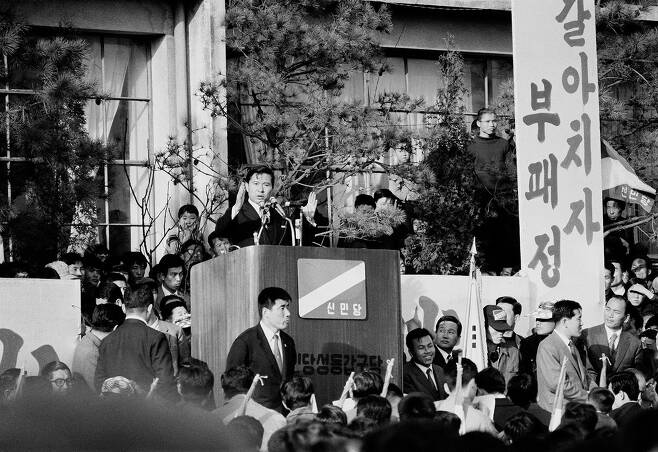At the baseball stadium, ‘Kim Dae-jung’ In the days when I cried out, this movie has the answer
[Reporter Seo Bu-won]
 |
| ▲ Documentary film <Kim Dae-jung on the Road> Poster image |
| ⓒ Myung Film |
Rather than a movie, I think it should be called a “modern history textbook.” The documentary film <Kim Dae-jung on the Road> was released on the 10th. It’s a story. The main character is former President Kim Dae-jung, but the spatiotemporal background is the turbulent modern history of the Republic of Korea from before and after liberation to the June 1987 democratic uprising.
It exactly matches the modern history section of current high school textbooks. Afterwards, the peaceful regime change, Sewol Ferry Disaster, and Candlelight Revolution are briefly introduced in ‘3 Kim Splits’, but they are rarely included in exams and are regarded as an ‘appendix’. Children’s history studies usually end with the June Democratic Uprising, just like in the movies.
In the movie, major events in modern history are mentioned without fail. Coincidentally, the reasons why Kim Dae-jung entered politics and how he grew into a major politician are events that are memorized by underlining them in textbooks. I think it will be an extremely useful reference book that brings life to the dry textbook descriptions.
It is unknown how long the screening will continue, but it is a work tailored for group viewing with school children. It’s just a pity that we are currently on winter break. A text message was immediately sent to the children in the history club encouraging them to watch the show. Even so, last weekend, I went on a club field trip to Chilgok and Waegwan, Gyeongsangbuk-do, on the topic of Park Chung-hee and Baek Sun-yup.
 |
| ▲ Documentary film <Kim Dae-jung on the Road> Still image |
| ⓒ Myung Film |
“Who do you think is the most important person in understanding our modern history?”
This is a question asked to children as a topic before starting a modern history class. As expected, not only has it been narrowed down to three or four people, but even the rankings are very similar. Perhaps because it was limited to the period after liberation, Baekbeom Kim Gu was not included in the rankings, and some playful answers unexpectedly singled out President Yoon Seok-yeol.
Without hesitation, first place is Park Chung-hee, second place is Syngman Rhee, third place is Chun Doo-hwan, and after a while of tilting one’s head, Kim Dae-jung is mentioned. On rare occasions, Roh Moo-hyun and Kim Il-sung appear, but these are only names that elicit laughter of half ridicule and half surprise. This is evidence that far-right YouTubers such as Ilbe still have a significant influence.
I think that if you ask the older generation, you will get a similar answer. This is because the era is defined by the names of those in power at the time, and this is reflected in textbooks. Our modern history goes through the brief period of Prime Minister Jang Myon’s reign under the Rhee Syngman government and the long military dictatorships of the Park Chung-hee government, the Chun Doo-hwan government, and the Roh Tae-woo government.
Syngman Rhee’s Liberty Party dictatorship lasted 12 years, and after Park Chung-hee’s May 16 coup, the military dictatorship lasted a whopping 30 years. Excluding the current term of President Yoon Seok-yeol, the total period since the civilian government is less than 30 years. In this case, it is natural that the names of dictators come to mind first in our modern history.
However, those who have seen this movie will probably rank it differently. You will realize that Kim Dae-jung is the person who encompasses the eras of Syngman Rhee, Park Chung-hee, and Chun Doo-hwan, the undisputed first to third place, all at once. He entered politics after seeing Syngman Rhee’s attempt to amend the Constitution during the Korean War, and grew into a major politician by opposing Park Chung-hee, who planned a third constitutional amendment. After being sentenced to death by Chun Doo-hwan, who rose to power after the Gwangju Massacre, he rose to prominence as a world-class figure. I stood.
His eventful life, in which he overcame numerous hardships of death, was a mirror that clearly revealed the atrocities of dictators. People around him who lived at the same time testify that he was a thorn in the side of dictatorial power. Dictators were anxious to kill him, but he paid no heed and only advocated for democracy.
Just like Cho Bong-am, the leader of the Progressive Party who advocated for peaceful unification during the Rhee Syngman regime but was executed, the unlegitimized dictatorship drove its political opponents out as “reds” whenever there was a crisis of power. They did not kill people because they were ‘communists,’ but it was not uncommon to kill them and then turn them into ‘commies’. The division of North and South Korea and ideological conflict were used as tools to maintain power.
This movie is likely to be quite a shock to those who still believe him to be a communist. It turns out that the image of a ‘communist’ that followed him throughout his life was created by Chun Doo-hwan’s new military government. They blamed the Gwangju massacre on regional sentiments and intentionally distorted and fabricated it by claiming that Kim Dae-jung, who was in prison at the time, was behind the scenes and manipulated it.
During the Korean War, he was accused of being a right-wing figure and was almost executed by the Communist Party. Although the labeling of him as a “communist” was completely incongruous, the Chun Doo-hwan government was ruthless. The media, which rushed to publish so-called ‘miss news’, also collaborated with the regime. In this way, Kim Dae-jung was labeled a ‘communist’, and the citizens of Gwangju who demanded his release at the time of May 18 were also branded’commies’.
“The Haitai Tigers won the Korean Professional Baseball Series, so why did everyone in the crowd shout the name Kim Dae-jung in unison?”
There is no longer a need to explain this question, which was a puzzling question from an acquaintance who was a baseball fanatic a long time ago. Anyone who sees this movie will nod their head. For the people of Gwangju and Honam at the time, who had no place to complain even after being unjustly killed by the new military government’s guns and swords, the baseball stadium was the only ‘Haewon’s rite’.
Kim Dae-jung, Gwangju, and Honam were bound together as a ‘common destiny’ by unjust power. Kim Dae-jung, who was in prison, could not help but feel indebted to those who sacrificed their lives while calling for his release. The cheers of Kim Dae-jung that echoed through the baseball stadium were actually a wish for democracy and a pledge to overthrow the dictatorship.
 |
| ▲ Documentary film <Kim Dae-jung on the Road> Still image |
| ⓒ Myung Film |
The movie ends with Kim Dae-jung visiting the May 18 Mangwol Cemetery immediately after the June Democratic Uprising. In the scene where Kim Dae-jung and his wife, Lee Hee-ho, shed tears at the graveyard, all the older audience members cried together. It was a moment that made me realize that tears of self-reproach and compassion for the victims of injustice are the first virtue of a politician.
If you focus on the events, it is the best ‘modern history textbook’, but if you focus on the person named Kim Dae-jung, it is a must-read for those who dream of becoming a politician. As you follow his life in the movie, you will automatically learn what qualities a politician needs. The admonition, “Become a scholar’s critical mind and a merchant’s sense of reality,” is actually a political philosophy drawn from his life story.
You may be busy preparing for the upcoming general election, but this is a movie I hope President Yoon Seok-yeol will also make time to see. Even if the domestic and international situations and historical environments are different, the qualities and virtues required of political leaders are not different. I hope that the life of Kim Dae-jung, a politician who risked his life to protect democracy in the harsh political environment of the Cold War and military dictatorship, can be used as a direct lesson.
Sajok. The elderly people who shed tears with Kim Dae-jung in the movie said this as they left the movie theater. “It might block the screening in other towns.”Even though it was released simultaneously across the country, I just waved my hand. He said that even now, when he travels to other places, he is careful about his dialect to hide that he is from Honam.
‘Commies’ fabricated by the military dictatorship and the collaborator media. The fear of stigma remains even decades later. Instead of apologizing, the perpetrators are still in awe, but the victims are intimidated and cower. Anyone who is aware of the reality that their values are on their hands must watch this movie.
- Gong Myung “‘younger brother’ NCT Doyoung, I was going to use it… “They willingly help.” [Ex’s interview]
- 31-0 loss, ‘last place in soccer’ A great turnaround for the national team
- Gong Myung “After being discharged from the military, I became a man… “I got hit with a smirk.” Recognition of change [Ex’s interview]
- ‘Alien+Human’ Part 2 exceeds 1 million, ranked 1st for 2 consecutive weekends [Box Office]

![Angelina Jolie’s daughter Shiloh turns 18, “Should I go to college or turn professional?” [Overseas Issue]](https://cdn.rubensays.com/wp-content/uploads/2024/01/20240122140656473twpp-1-64x64.webp)

![‘Idol Pick’ Kang Daniel, the idol who looks good with this year’s color ‘Peach Fuzz’ [DA:Chart]](https://cdn.rubensays.com/wp-content/uploads/2024/01/20240122140521443iwgv-1-64x64.webp)

![Jo Se-ho, his thoughts on his relationship, “I have found someone precious, and I want to be with them for a long time.” [specialty]](https://cdn.rubensays.com/wp-content/uploads/2024/01/20240122122249645unhk-1-64x64.webp)
![‘Touch Me’ Samantha Fox, drunk at the highest level ever… Delayed takeoff of plane, causing damage to passengers [Hollywood News]](https://cdn.rubensays.com/wp-content/uploads/2024/01/20240122122006709cknb-1-64x64.webp)
![‘Without blood or tears’ Lee So-yeon and Ha Yeon-joo, sisters who met through their father-in-law…a bloody and cruel narrative [Comprehensive]](https://cdn.rubensays.com/wp-content/uploads/2024/01/20240122121517416hzaz-1-64x64.webp)
![Kim Kardashian and Kanye West meet for children after divorce… Breathtaking atmosphere [Hollywood News]](https://cdn.rubensays.com/wp-content/uploads/2024/01/20240122121434539eczd-1-64x64.webp)
![“It’s different from existing daily dramas”… Confidence of ‘Without blood and tears’ [Comprehensive]](https://cdn.rubensays.com/wp-content/uploads/2024/01/20240122121413487wcqb-1-64x64.webp)
Leave a Reply